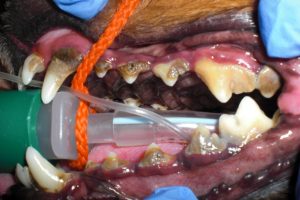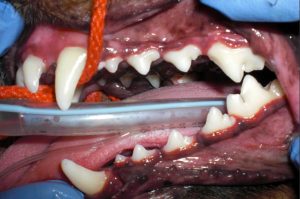February is widely known in the veterinary industry as Dental Month. Did you know that dental disease is one of the top two health concerns identified in pets today? We estimate that 80% of cats and dogs over the age of 3 have some degree of dental disease. You may not know that your pet has dental disease, or maybe your vet has mentioned it to you. What about plaque, tartar and gingivitis? How do all of these components of oral health factor in to what’s known as dental disease?
Your pet’s mouth and yours aren’t so different, after all…
We all love that clean, smooth feeling our teeth have after we brush our teeth, right? Remember the feeling when you first wake up in the morning, or if you forget to brush your teeth? Your teeth are no longer smooth; they almost feel “filmy”… why is that, you ask? Bacteria that is naturally present in our mouth forms on our teeth, creating a film called plaque. We are able to remove this film by brushing our teeth twice daily and by scheduling routine visits with our dentists. Unfortunately, the majority of owners do not brush their pets teeth as often as they brush their own. As a result, the plaque builds up, not only on the surface of the teeth, but under the gumline as well. The bacteria that forms plaque feed on enzymes in saliva and hardens into what is commonly known as tartar. Dental tartar is unable to be brushed off of teeth because it is so hard, and in fact, bacteria clings to the tartar and the entire cycle continues.
The bacteria in Fluffy’s mouth can cause inflammation of the gums, which is known as Gingivitis. Left untreated, dental tartar and gingivitis can lead to worsening stages of periodontal (dental) disease, where bone loss around teeth can occur.
Just what is Periodontal Disease?
- There are four stages of periodontal disease; each stage more progressive than the last. Gingivitis and tartar become worse, and bone loss occurs around the teeth. Bone loss causes pockets to form around the teeth, which can lead to loose teeth, as well as abscesses. Don’t be fooled into thinking that house pets cannot get dental disease! Cats are just as likely as dogs to develop periodontal disease and may show the following symptoms:
– Red, swollen and sometimes bleeding gums
– Recession of the gums to where the roots of teeth can be seen
– Pus in between teeth and gums (leading to bad breath)
– Pain from loose teeth and sore gums, resulting in a reduced appetite or favouring one side of the mouth while eating
How serious is Periodontal Disease?
- Periodontal disease often gets brushed off as problem of minimal concern. If we don’t regularly examine our pets’ mouths, we may not see the symptoms listed above. Our pets are exceptional at hiding pain; however, if you think about your own experiences with cavities or other dental problems, you know how painful it can be. If periodontal disease is allowed to progress, your pets’ gums become more irritated and bleed easily. This provides bacteria in the mouth access to the blood stream. These bacteria now have access to your pet’s whole body, including vital organs such as the heart, liver and kidneys. Periodontal disease can therefore result in a serious heart condition known as endocarditis (infection of the heart valves) or infection of the kidneys.
What can be done about dental disease?
- If you suspect your pet might have dental disease you should mention your concern to your veterinarian. The best and safest treatment for dental disease is a full cleaning. It is important that your pet be anesthetized for this procedure so that the mouth can be thoroughly examined and every surface scaled and polished. It is important for us to be able to clean below the gumline where a lot of the bacteria hide. Any extractions that need to be performed can be done at the same time. Before anesthesia your veterinarian will check your pet carefully for other health concerns that might increase his/her risk for anesthesia, and may also draw blood to check for unseen problems with your pet’s organs. If no major concerns are identified anesthesia is a relatively low risk procedure and the benefit your pet will receive from having a healthy mouth will be well worth it.
So now you’ve heard all the things that come in hand with dental disease, and what we as veterinary professionals can do to aid your pet in having great oral hygiene. You’re probably wondering what you as a responsible pet owner can do at home to prevent plaque and tartar from accumulating! Tune in next week and we’ll show you!



